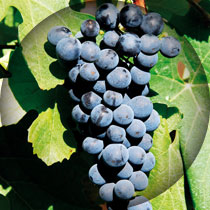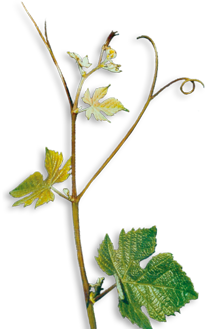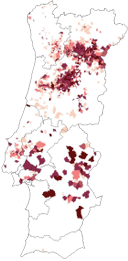Touriga-Nacional (PT)
Variety: red | Category I | Portugal


General Information
Touriga-Nacional


Origin: Northern Portugal. Classified by Lacerda Lobo (1790) as being from the sub-regions of the Douro and the Beiras. Rebelo da Fonseca described this variety in 1791. Chief areas of distribution: Initially in the Dão and the Douro, but has spread to all regions in the last decade.
Chief areas of distribution: Spain, South Africa, Australia (39 ha), California, and Brazil.
Official synonym(s) (national and OIV): Touriga (AU).
Historic and regional synonyms: Preto Mortágua (Dão, Setúbal), Tourigo (Dão), Touriga Fina (Douro), Alvarelhão (because of variety confusion in California).
Homonym(s): There is a white Touriga (Nº 319), the Touriga Fêmea variety (Nº 311), and the Touriga Franca variety (Nº 312).
Area under cultivation: 6,700 ha.
New plantings: 10.35%.
Trend: Clear upward.
Varietal variability: Average.
Availability of propagating material: Selected polyclonal material to maintain biodiversity(RNSV);
Molecular Profile (OIV)
Regional Classification
Morphology
Phenology
Vegetative Potential
Viticultural Parameters
Oenology
Variety Characteristics
| VVMD5 | VVMD7 | VVMD27 | VrZag62 | VrZag79 | VVS2 | ||||||
| Allele1 | Allele2 | Allele1 | Allele2 | Allele1 | Allele2 | Allele1 | Allele2 | Allele1 | Allele2 | Allele1 | Allele2 |
| 226 | 226 | 235 | 235 | 181 | 189 | 189 | 188 | 194 | 245 | 145 | 153 |
Young shoot (form of tip): Open, with crimson red tip, medium hair density.
Young leaf: Green with light copper shading, hairs of medium density on ventral side.
Inflorescence (sex of flower): Hermaphrodite.
Mature leaf: Small, pentagonal, five lobes, upper side of blade medium green, even and blistered. Erect hairs of medium density on lower side of blade, rectilinear short teeth. Open U-shaped petiolar sinus. Open U-shaped upper lateral sinuses.
Bunch: Small, cylindrical to conical, of medium density, peduncle of medium length.
Berry: Of medium size, slightly oblate, blue-black. Berry skin of medium thickness, soft flesh.
Woody shoot: Dark brown.
Time of bud burst: Early, 2 days before the Castelão.
Flowering: Early, at the same time as the Castelão.
Berry (colour change): Normal, 2 days after the Castelão.
Berry (harvest ripe): Normal, one week after the Castelão.
Vigour of shoot growth: High.
Pruning weight:: 1,750 – 3,500 t/ha, depending on clone and environmental conditions.
Shoot attitude (habit): Plagiotropic, although drooping when longer.
Length of internodes: Medium to short, regular.
Shoot length: Medium, some very long.
Tendency to form lateral shoots: Medium to high.
Rate of multiple bud bursts: Very short, often herbaceous, although in cases of high vigour of shoot growth (after short pruning) they may be longer.
Bud fertility index: Very high.
Yield: Often very low with traditional material (3 - 5 t/ha). With clonal material the yield can be very high (8 - 15 t/ha). RNSV statistical value: 0.88 kg/vine (Average of at least 40 clones in Vila Nova de Foz Côa over 4 years).
Yield consistency: Quite high with clone material.
Winkler Index: 1,606 – produces an 11 t/h yield. Despite its high thermic requirement, variety has good ripening potential since it is stable in terms of rot and oxidation.
Sensitivity to abiotic factors: Leaves dry out in drought, and in certain situations of magnesium deficiency.
Susceptibility to fungal diseases: Low susceptibility to Oidium, high susceptibility to Excoriosis (Phomopsis viticola Sacc.).
Systemic viral infection prior to selection: 17% GLRaV-1, 30% GLRaV-3, 10% GLRaV-2 and -6, 25% GFkV, >50% RSPV.
Susceptibility to Pests: High resistance to the vine leaf hopper and caterpillars.
Bunch size: Small and medium (100 - 250 g).
Bunch density: Medium.
Berry size: Small (0.9 – 1.8 g), varies with environment and clone, difficult to detach.
Berry skin: Medium firmness.
Seeds per berry: High, 2.4.
Soil requirement: All soil types, except very fertile and moist soils.
Climatic requirements: High levels of irradiation, heat.
Vine density: Any configuration is possible, as long as the vine conduction system and pruning are appropriate to the vine. In practise, however, between 3,000 and 4,000 vines/ha at most is recommended.
Rootstock: Performs better with lower vigour rootstock varieties. Compatible with most rootstocks. Recommended rootstocks include Ru 140, Aramon and Rupestris du Lot.
Irrigation: Well suited, but has a high water requirement to achieve physiological balance.
Incidence of coulure/millerandage: Originally extremely susceptible. Low susceptibility with well selected clones.
Spoilage of mature berries: Late harvest variety. Very resistant to Autumn rainfall.
Risk of bird damage: No particular risk.
Machine harvest suitability: Technically not possible in the Douro (main area of cultivation), although possible elsewhere at lower temperatures.
Wine type: Table wine and quality wine, Port wine, sparkling wine, rosé wine.
Potential alcohol content: High (14% vol.). RNSV statistical average: 12.29% vol. (Average of at least 40 clones in Vila Nova de Foz Côa over 6 years).
Natural acidity of must: Medium to high, 4,5 - 6,0 g/l total; (malic acid: 1,2 g/l, tartaric acid: 4,3 g/l). RNSV statistical average: 3,57 g/l (Average of at least 40 clones in Vila Nova de Foz Côa over 5 years).
Total phenols index (at 280 nm) of must: 50 – 80; varies depending on clone and time of harvest.
Risk of oxidation of must: Low.
Colour intensity of wine: 10 - 20; varies depending on clone and time of harvest.
Wine colour tonality: 0,6 - 0,8.
Risk of oxidation of wine: Low.
Aromatic profile: (Analyses performed in the Douro, 1999). The wine of this variety has the highest concentration of free terpenoids (150 μg/l), which are responsible for its fruity aromas and give it its sensory distinction. Particular mention should be made of its 50% linalool content.
Ageing Potential: Very high, particularly suitable to barrel ageing.
Blending recommendation: Touriga Franca, Tinto Cão, Trincadeira, Tinta Barroca, Alfrocheiro.
Suitable as a varietal: Particularly suitable.
Wine Descriptors: The Touriga presents itself as rich, round and warm, and is evocative of dark red fruits of the forest; it is very mature, with some fruity passages, dominated, however, by violet. In good years, it brings forth a delightful perfume, not unlike the Cistus. (N. Almeida, 92).
Wine quality: Very high, premium grapevine variety (according to the Porter Cluster).
Variety Characteristics: Premium grapevine variety with the highest oenological potential in hot viticultural regions. Its intense colour and aroma give it a high degree of complexity. Its most highly valued properties cannot develop in insufficent sunglight or under extreme drought stress. The variety needs rapid, effective treatment against Excoriosis (Phomopsis viticola Sacc.) in Spring. Some of the new clones are very productive, which can be lost, however, if yields are not well regulated in the early years.

